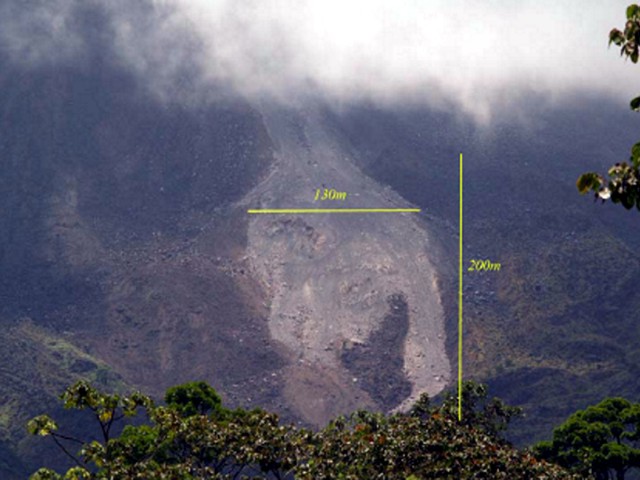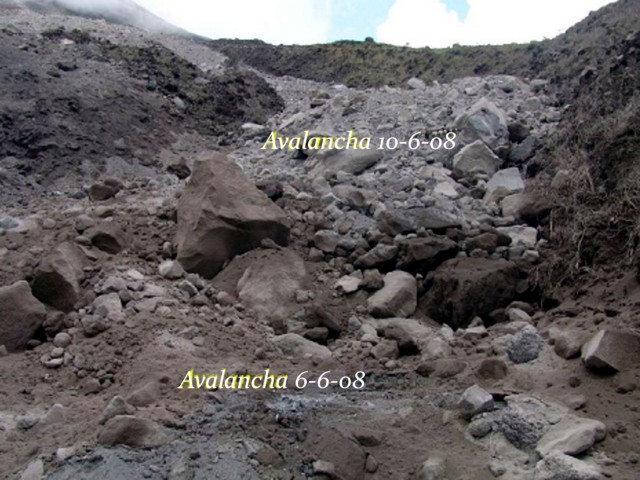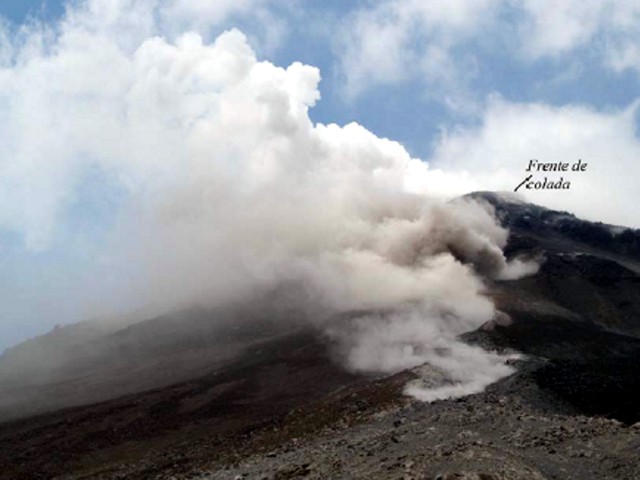Report on Arenal (Costa Rica) — June 2008
Bulletin of the Global Volcanism Network, vol. 33, no. 6 (June 2008)
Managing Editor: Richard Wunderman.
Arenal (Costa Rica) Continuing explosive and effusive eruptions; block-and-ash flows
Please cite this report as:
Global Volcanism Program, 2008. Report on Arenal (Costa Rica) (Wunderman, R., ed.). Bulletin of the Global Volcanism Network, 33:6. Smithsonian Institution. https://doi.org/10.5479/si.GVP.BGVN200806-345033
Arenal
Costa Rica
10.463°N, 84.703°W; summit elev. 1670 m
All times are local (unless otherwise noted)
Our last report covered generally low-level activity at Arenal through September 2007 (BGVN 32:09). Behavior then included pyroclastic flows to a runout distance of ~ 1 km and a new lava flow emerging from Crater C. This report covers the interval October 2007?June 2008 and originated from those of both the Observatorio Vulcanologico Sismologica de Costa Rica- Universidad Nacional (OVSICORI-UNA) and (ICE).
Impressive incandescent avalanches (block-and-ash flows or pyroclastic flows) traveled down several flanks during June 2008. At least portions of those avalanches broke off from a cone in Crater C and active lava flows high on the edifice.
During the reporting interval, Crater C continued to produce lava flows, gases, sporadic Strombolian eruptions, and avalanches from the lava flow fronts. Observers noticed acid rain and small amounts of ejected pyroclastic material impacting the NE, E, and SE flanks. They also cited loss of vegetation, steep slopes, poorly consolidated material, and high precipitation as factors that triggered small cold avalanches in Calle de Arenas, Manolo, Guillermina, and the river Agua Caliente. Crater D remained fumarolic. Except for the June avalanches, eruptive activity generally remained modest. Some reports noted that the eruptive vigor continued to drop both in terms of the number of eruptions and the amount of ejected pyroclastic material.
OVSICORI-UNA reported that by March 2008, the flow of lava down the S flank had stopped, but a new flow that had begun in February 2008 toward the SW flank was still active. A few eruptions produced ash columns that exceeded 500 m above the vent.
During April 2008, lava moving toward the S flank descended to about 1,400 m elevation. Some blocks had detached near the border of the crater. Sporadically small avalanches occurred and some blocks managed to reach vegetation below, igniting small fires. Some April eruptions produced dark gray ash columns.
Glowing avalanches of June. Jorge Barquero sent us a report on Arenal's behavior during June 2008. Prior to the June events a distinct cone had appeared in Crater C. Its steep sides generated small avalanches of loosened rocks. At about 1000 on 6 June, that cone collapsed, causing a pyroclastic (block-and-ash) flow that descended SE, forming a gully or channel, and laying down a deposit that fanned out at the base of Arenal. Lava also descended into or towards the gully, causing small avalanches.
Some residents heard noises and felt ashfall starting at 0600 on 10 June. At about 0800 these block-and-ash flows became larger. The wind blew ash NW to 4 km from the crater.
After 1730 on 14 June, the failure of the lava flow front sent down an avalanche more violent than those earlier. An hour later the largest block-and-ash flow of the month descended. It descended the channel and produced a large quantity of ash that blew SE and W to distances of 6 km. The area of greatest impact was in the SW portion of the Arenal National Park, where the branches of some vegetation cracked under the weight of the ash. More block-and-ash flows were also observed on 15 and 18 June.
On 11 June Eliecer Duarte and E. Fernández (OVSICORI-UNA) visited the distal parts of the new deposits, documenting the new flow field (figures 102 and 103). The distal area occurred at ~ 900 m elevation on Arenal's outer margins where the slope changes abruptly. A series of alternating lobes contained deposits that were 500°C on 11 June. The individual lobe's thickness reached up to about 3-4 m. The heterogeneous nature of the often angular blocks contrasted with a gray and quite sandy matrix, and included both pre-existing material eroded from the valley walls and more recent juvenile material from the summit. Conspicuous blocls from the block-and-ash flow (10% were 2-3 m in diameter and ~ 20% were ~ 1 m in diameter) are mostly juvenile material from the lava flow. The margins of the fan were covered by a fine dust layer several centimeters thick. On the S flanks, the block-and-ash deposit barely reached a few meters thick. On the N flanks, the deposit reached many tens of meters thick, the result of wind carrying the abundant fine materials in that direction.
 |
Figure 102. A view of the early June 2008 incandescent avalanche deposits on Arenal's S flanks. Courtesy of OVSICORI-UNA. |
 |
Figure 103. Previously incandescent avalanche deposits at Arenal seen on 11 June 2008. Courtesy of OVSICORI-UNA. |
Major S-flank avalanches reported on 6 and 10 June 2008 eroded a radially oriented gully (an avalanche chute). Later avalanches down this direction tended to form channelized deposits. A dark colored thick lava flow present at the summit (figure 104) provided an important source of materials in the deposits. The S-flank avalanches funneled through the gully, fracturing particles into finer grain sizes and generating columns of ash. During the visit, the team observed several avalanches containing large blocks that were similarly reduced in volume as they bounced through the gully. Some of these blocks arrived at the lower part of the fan with temperatures between 800 and 1,000°C. The large blocks seemingly cracked as the result of thermal shock, a process accelerated during a strong rainstorm.
Geological Summary. Conical Volcán Arenal is the youngest stratovolcano in Costa Rica and one of its most active. The 1670-m-high andesitic volcano towers above the eastern shores of Lake Arenal, which has been enlarged by a hydroelectric project. Arenal lies along a volcanic chain that has migrated to the NW from the late-Pleistocene Los Perdidos lava domes through the Pleistocene-to-Holocene Chato volcano, which contains a 500-m-wide, lake-filled summit crater. The earliest known eruptions of Arenal took place about 7000 years ago, and it was active concurrently with Cerro Chato until the activity of Chato ended about 3500 years ago. Growth of Arenal has been characterized by periodic major explosive eruptions at several-hundred-year intervals and periods of lava effusion that armor the cone. An eruptive period that began with a major explosive eruption in 1968 ended in December 2010; continuous explosive activity accompanied by slow lava effusion and the occasional emission of pyroclastic flows characterized the eruption from vents at the summit and on the upper western flank.
Information Contacts: E. Fernández, E. Duarte, W. Sáenz, V. Barboza, M. Martinez, E. Malavassi, and R. Sáenz, Observatorio Vulcanologico Sismologica de Costa Rica-Universidad Nacional (OVSICORI-UNA), Apartado 86-3000, Heredia, Costa Rica (URL: http://www.ovsicori.una.ac.cr/); Jorge Barquero Hernandez, Instituto Costarricense de Electricidad (ICE), Apartado 5 -2400, Desamparados, San José, Costa Rica.


